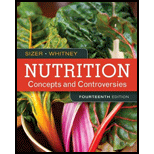
Nutrition: Concepts and Controversies - Standalone book (MindTap Course List)
14th Edition
ISBN: 9781305627994
Author: Frances Sizer, Ellie Whitney
Publisher: Brooks Cole
expand_more
expand_more
format_list_bulleted
Concept explainers
Textbook Question
Chapter 14, Problem 12SC
In research, which of the following is associated with a longer life span in many species?
a. energy restriction
b. superoxide dismutase
c. omega-3 fatty acids
d. none of the above
Expert Solution & Answer
Want to see the full answer?
Check out a sample textbook solution
Chapter 14 Solutions
Nutrition: Concepts and Controversies - Standalone book (MindTap Course List)
Ch. 14 - Prob. 1RQCh. 14 - Prob. 2RQCh. 14 - Prob. 3RQCh. 14 - Prob. 1CTCh. 14 - Prob. 2CTCh. 14 - Prob. 1SCCh. 14 - Prob. 2SCCh. 14 - Prob. 3SCCh. 14 - Prob. 4SCCh. 14 - Prob. 5SC
Ch. 14 - Prob. 6SCCh. 14 - Prob. 7SCCh. 14 - Prob. 8SCCh. 14 - Prob. 9SCCh. 14 - Prob. 10SCCh. 14 - Prob. 11SCCh. 14 - In research, which of the following is associated...Ch. 14 - Prob. 13SCCh. 14 - Prob. 14SCCh. 14 - Prob. 15SCCh. 14 - Prob. 16SCCh. 14 - The word DETERMINE is an acronym used in assessing...Ch. 14 - Prob. 18SCCh. 14 - Prob. 19SC
Additional Science Textbook Solutions
Find more solutions based on key concepts
Define histology.
Fundamentals of Anatomy & Physiology (11th Edition)
2. Why is it that the range of resting blood pressures of humans is best represented by a bell-shaped curve co...
Human Biology: Concepts and Current Issues (8th Edition)
45. Calculate the mass of nitrogen dissolved at room temperature in an 80.0-L home aquarium. Assume a total pre...
Chemistry: Structure and Properties (2nd Edition)
Separate the list P,F,V,,T,a,m,L,t, and V into intensive properties, extensive properties, and nonproperties.
Fundamentals Of Thermodynamics
Give the IUPAC name for each compound.
Organic Chemistry
Describe the evolution of mammals, tracing their synapsid lineage from early amniote ancestors to true mammals....
Loose Leaf For Integrated Principles Of Zoology
Knowledge Booster
Learn more about
Need a deep-dive on the concept behind this application? Look no further. Learn more about this topic, health-nutrition and related others by exploring similar questions and additional content below.Similar questions
- The surface-to-volume ratio _______. a. does not apply to prokaryotic cells. b. constrains cell size. c. is part of the cell bodyarrow_forward_______ are oxygen-releasing photoautotrophs. a. Spirochetes c. Cyanobacteria b. Methanogens d. Bacteriophagesarrow_forwardA ribozyme consists of ___________. a. clay c. DNA b. lipids d. RNAarrow_forward
- A typical prokaryotic cell ________ compared to a eukaryotic cell. a. is smaller in size by a factor of 100 b. is similar in size c. is smaller in size by a factor of one million d. is larger in size by a factor of 10arrow_forwardMitochondria most likely evolved from_______. a. a photosynthetic cyanobacterium b. cytoskeletal elements c. aerobic bacteria d. membrane proliferationarrow_forwardWhich of the following statements is correct? a. Ribosomes are only found in bacteria and archaea. b. Some animal cells are prokaryotic c. Only eukaryotic cells have mitochondria d. The plasma membrane is the outermost boundary of all cells. e. Some cell membranes do not consists of lipids.arrow_forward
- Prokaryotes that obtain their energy from chemical compounds are called _____. a. photorophs b. auxotrophs c. chemorophs d. lithotrophsarrow_forwardEukaryotic and prokaryotic ribosomes are similar in that: a. both contain a small subunit, but only eukaryotes contain a large subunit. b. both contain the same number of proteins. c. both use mRNA to assemble amino acids into proteins. d. both contain the same number of types of rRNA. e. both produce proteins that can pass through pores into the nucleus.arrow_forwardWhen viewing a specimen through a light microscope, scientists use ______ to distinguish the individual components of cells. a. a beam of electrons b. radioactive isotopes c. special stains d. high temperaturesarrow_forward
- What is the role of Agrobacterium tumefaciens in the production of transgenic plants? a. Genes from A. fume fociens are inserted into plant DNA to give the plant different traits. b. Transgenic plants have been given resistance to the pest A. tumefacaens. c. A. wmefaciens is used as a vector to move genes into plant cells. d. Plant genes are incorporated into the genome of Agrobacterium tumefaciens.arrow_forwardWhich of the following consist of prokaryotic cells? a. bacteria and fungi b. archaea and fungi c. protists and animals d. bacteria and archaeaarrow_forwardA promoter is ______. a. a specific sequence of DNA nucleotides b. a specific sequence of RNA nucleotides c. a protein that binds to DNA d. an enzyme that synthesizes RNAarrow_forward
arrow_back_ios
SEE MORE QUESTIONS
arrow_forward_ios
Recommended textbooks for you
 Basic Clinical Lab Competencies for Respiratory C...NursingISBN:9781285244662Author:WhitePublisher:Cengage
Basic Clinical Lab Competencies for Respiratory C...NursingISBN:9781285244662Author:WhitePublisher:Cengage Comprehensive Medical Assisting: Administrative a...NursingISBN:9781305964792Author:Wilburta Q. Lindh, Carol D. Tamparo, Barbara M. Dahl, Julie Morris, Cindy CorreaPublisher:Cengage Learning
Comprehensive Medical Assisting: Administrative a...NursingISBN:9781305964792Author:Wilburta Q. Lindh, Carol D. Tamparo, Barbara M. Dahl, Julie Morris, Cindy CorreaPublisher:Cengage Learning Concepts of BiologyBiologyISBN:9781938168116Author:Samantha Fowler, Rebecca Roush, James WisePublisher:OpenStax College
Concepts of BiologyBiologyISBN:9781938168116Author:Samantha Fowler, Rebecca Roush, James WisePublisher:OpenStax College Principles Of Radiographic Imaging: An Art And A ...Health & NutritionISBN:9781337711067Author:Richard R. Carlton, Arlene M. Adler, Vesna BalacPublisher:Cengage Learning
Principles Of Radiographic Imaging: An Art And A ...Health & NutritionISBN:9781337711067Author:Richard R. Carlton, Arlene M. Adler, Vesna BalacPublisher:Cengage Learning


Basic Clinical Lab Competencies for Respiratory C...
Nursing
ISBN:9781285244662
Author:White
Publisher:Cengage

Comprehensive Medical Assisting: Administrative a...
Nursing
ISBN:9781305964792
Author:Wilburta Q. Lindh, Carol D. Tamparo, Barbara M. Dahl, Julie Morris, Cindy Correa
Publisher:Cengage Learning

Concepts of Biology
Biology
ISBN:9781938168116
Author:Samantha Fowler, Rebecca Roush, James Wise
Publisher:OpenStax College


Principles Of Radiographic Imaging: An Art And A ...
Health & Nutrition
ISBN:9781337711067
Author:Richard R. Carlton, Arlene M. Adler, Vesna Balac
Publisher:Cengage Learning
Bacterial Genomics and Metagenomics; Author: Quadram Institute;https://www.youtube.com/watch?v=_6IdVTAFXoU;License: Standard youtube license